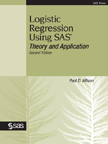In Paul Allison’s own words, “It’s about time!” The first edition of his book on logistic regression came out in 1999, and since then, “there have been an enormous number of changes and enhancements to the SAS procedures for doing logistic regression and related methods.”
Allison has incorporated those changes in Logistic Regression Using SAS: Theory and Application, Second Edition. Informal and nontechnical, the book explains the theory behind logistic regression and looks at all the practical details involved in its implementation using SAS.
The second edition describes many new features of PROC LOGISTIC, including conditional logistic regression, exact logistic regression, generalized logit models, ROC curves, the ODDSRATIO statement, and the EFFECTPLOT statement. Also new is coverage of PROC SURVEYLOGISTIC, PROC GLIMMIX, PROC QLIM, and PROC MDC.
Whether you’ve delved into these new features yet or not, I thought the publication of the new edition was a good time to step back and ask the broader question, “What are the top 3 things everyone should know about logistic regression?” Allison gave us his expert opinion:
- Doing logistic regression is not all that different from ordinary linear regression. You just have to choose a dependent variable and a set of independent variables. And what you do with those independent variables is pretty much the same as with linear regression. You can transform them, interact them, or create sets of dummy variables.
- The big difference between logistic regression and linear regression is the interpretation of effects. In logistic regression, variable effects are typically interpreted by way of odds ratios. So you need to have a very clear understanding of odds and odds ratios.
- Sometimes logistic regression coefficients don’t exist. That’s another big difference from linear regression. Logistic regression coefficients are estimated by maximizing the likelihood. But for some data patterns, there is no coefficient value that maximizes the likelihood. Fortunately, SAS has some cool solutions for this problem.
Find out more about topics covered in the book, read a free chapter, and get your copy today!
2 Comments
Hi Irfan,
Thank you for reading our blog and for inquiring about the logistic regression model. Our SAS Technical Support group will be able to help you with your question. Please contact them at: http://support.sas.com/techsup/contact/
Best wishes and thank you for using SAS
Best wishes
Hi!
I have an issues, In my logistic regression model most(90%) of the estimated probabilities are less then 0.1. but my model has very good concordance and AUC.
Is there any way/technique to increase estimated probabilities values? so that they are distributed across 0 to 1.
Thanks,
Irfan Khan